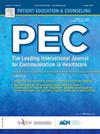共享决策的观察者OPTION-5测量自动化:通过比较大型语言模型和人类评分来评估有效性
IF 3.1
2区 医学
Q2 PUBLIC, ENVIRONMENTAL & OCCUPATIONAL HEALTH
引用次数: 0
摘要
基于观察者的共同决策方法依赖于人工评分,资源密集,限制了常规评估和改进。生成式人工智能可以提高基于观察者的评估的速度和准确性,同时减少负担。本研究旨在评估来自Gemini、GPT和LLaMA家族模型的大型语言模型(llm)在评估临床医生和考虑早期乳腺癌手术的女性之间共同决策程度方面的表现。方法采用5项观察者OPTION-5测量方法,将sllm生成的评分与随机对照试验中训练过的人类评分进行比较。我们分析了287份乳腺癌咨询的匿名记录。在模型中测试了一系列提示,评估了与人类得分的相关性。我们还评估了法学硕士区分高与低相遇的能力,以及评级间协议对绩效的影响。1结果gpt - 40和Gemini-1.5-Pro-002生成的Observer OPTION-5项目得分与人类评分的相关性(Pearson r ≈ 0.6,p值<;0.01),占人类评分者自身相关性的≈ 75-80 % (r = 0.77)。提供详细的描述和示例可以提高模型的性能。结果还证实,模型可以区分高分和低分的相遇,独立样本t检验显示两组之间存在巨大且显著的分离(t >; 10,p <; 0.01)。基于我们探索的乳腺癌手术数据集,法学硕士可以使用现有措施评估临床-患者对话的各个方面,为提示的开发和微调提供基础。未来的工作应该集中在一般化、更大的数据集和改进模型性能上。实践意义能够自动评估共享决策的前景为快速反馈打开了大门,作为反思实践改进的一种手段。本文章由计算机程序翻译,如有差异,请以英文原文为准。
Automating the Observer OPTION-5 measure of shared decision making: Assessing validity by comparing large language models to human ratings
Objectives
Observer-based measures of shared decision rely on human raters, it is resource-intensive, limiting routine assessment and improvement. Generative artificial intelligence could increase the speed and accuracy of observer-based evaluation while reducing the burden. This study aimed to assess the performance of large language models (LLMs) from Gemini, GPT, and LLaMA family of models in evaluating the extent of shared decision-making between clinicians and women considering surgery for early-stage breast cancer.
Methods
LLM-generated scores were compared with those of trained human raters from a randomized controlled trial using the 5-item Observer OPTION-5 measure. We analyzed 287 anonymized transcripts of breast cancer consultations. A series of prompts were tested across models, assessing correlations with human scores. We also evaluated the ability of LLMs to distinguish high versus low encounters and the impact of inter-rater agreement on performance.1
Results
The scores for Observer OPTION-5 items generated by the GPT-4o and Gemini-1.5-Pro-002 correlated with human ratings (Pearson r ≈ 0.6, p-value<0.01), representing ≈ 75–80 % of the correlation observed between human raters themselves (r = 0.77). Providing detailed descriptions and examples improved the models’ performance. The results also confirm that the models could distinguish high- from low-scoring encounters, with an independent-samples t-test showing a large and significant separation between the two groups (t > 10, p < 0.01).
Conclusions
Based on the breast cancer surgery dataset we explored, LLMs can evaluate aspects of clinician-patient dialog using existing measures, providing the basis for the development and fine-tuning of prompts. Future work should focus on generalizability, larger datasets, and improving model performance.
Practice implications
The prospect of being able to automate the assessment of shared decision-making opens the door to rapid feedback as a means for reflective practice improvement.
求助全文
通过发布文献求助,成功后即可免费获取论文全文。
去求助
来源期刊

Patient Education and Counseling
医学-公共卫生、环境卫生与职业卫生
CiteScore
5.60
自引率
11.40%
发文量
384
审稿时长
46 days
期刊介绍:
Patient Education and Counseling is an interdisciplinary, international journal for patient education and health promotion researchers, managers and clinicians. The journal seeks to explore and elucidate the educational, counseling and communication models in health care. Its aim is to provide a forum for fundamental as well as applied research, and to promote the study of organizational issues involved with the delivery of patient education, counseling, health promotion services and training models in improving communication between providers and patients.
 求助内容:
求助内容: 应助结果提醒方式:
应助结果提醒方式:


